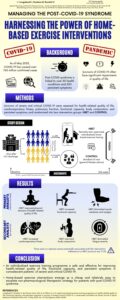Harnessing the Power of Home-based Exercise Interventions
Keywords: quality of life, functional capacity, exercise training
Why is this study important?
The World Health Organization (WHO) has recently announced that COVID-19 no longer constitutes a public health emergency of international concern. This, however, does not mean the end of the pandemic or of its short and long-term consequences. Convalescent patients of COVID-19 often experience a myriad of health impairments, including exertional intolerance, worse functional capacity, and persistent symptoms (eg, fatigue, muscle weakness, myalgia, and dyspnea) that directly impact their quality of life. In fact, the post-acute effects of COVID-19 have already revealed more than 200 symptoms and 50 health conditions that commonly develop or persist after SARS-CoV-2 infection that can last several months (or even years, particularly, in those who had acute severe/critical illness). Based on the available literature, the prevalence of this condition varies widely, ranging from approximately 10% to 80% of those who had been infected (1). Even though the numbers vary, in best estimates, we are talking about millions of people suffering from this condition worldwide. Therefore, the post-COVID-19 syndrome is still an ongoing health issue which deserves appropriate attention.
Exercise has been considered as a “medicine” for a broad spectrum of chronic diseases that, despite their distinct nature, share similar symptoms and manifestations (2). Resistance exercises have gathered widespread recognition for its efficacy in increasing skeletal muscle mass, strength and functionality, whereas endurance exercises are especially known for enhancing cardiorespiratory fitness. Both types of exercise also have been shown to alleviate fatigue and bodily pain (eg, myalgia). Due to the pandemic-imposed restrictions on accessing exercise centres, home-based exercise training emerges as a promising alternative. Considering the positive effects on a multitude of health-related outcomes (including quality of life), it was reasonable to assume a therapeutic role for a home-based exercise programme in the post-COVID-19 syndrome management. This blog will explore this further and is based on a study recently published in BJSM (3).
How did the study go about this?
We recruited 50 survivors of severe/critical COVID-19 (in line with WHO severity classification) and divided them randomly into two groups:
1) CONTROL (standard of care) and
2) HBET (home-based exercise training).
CONTROL received general lifestyle advice, while HBET followed a remotely semi-supervised training program tailored to each patient (based on their post-COVID functional status – PCFS score), in addition to standard of care. The training program included exercises to be performed at home using body weight or household materials, progressing over the weeks based on individual capacity and perceived exertion. In addition to online monitoring, patients also received support material, such as exercise cards providing instructions on how to properly perform each exercise. We assessed health-related quality of life, cardiorespiratory fitness, pulmonary function, functional capacity, body composition, and persistent symptoms at baseline and after 16 weeks.
What did the study find?
We found a meaningful effect of HBET on physical domains of health-related quality of life, reflecting improvements in functional capacity and some persistent symptoms (ie, muscle weakness and myalgia). Even considering suboptimal adherence (71.2%) to HBET, secondary analysis (per protocol) also revealed positive results in other outcomes, such as cardiorespiratory fitness, body composition, and fatigue severity, further supporting the benefits of exercise interventions for these patients. Conversely, we did not find significant effects on any psychological symptoms (eg, anxiety and depression), which we speculate stem from lack of social contact in combination with environmental issues (ie, performing exercise indoors).
What are the key take-home points?
- An individualised home-based exercise training programme is safe and effective to improve health-related quality of life, functional capacity, and persistent symptoms in patients recovering from severe/critical COVID-19.
- Home-based exercise interventions emerge as a cheap and relatively easy to escalate non-pharmacological therapeutic strategy for patients with post-COVID-19 syndrome.

Authors: Igor Longobardi,1 Bruno Gualano,1,2 Hamilton Roschel1,2
1 Applied Physiology and Nutrition Research Group – Center of Lifestyle Medicine, Faculdade de Medicina FMUSP, Universidade de São Paulo.
2 Rheumatology Division, Hospital das Clinicas HCFMUSP, Faculdade de Medicina, Universidade de São Paulo, São Paulo, SP, BR.
hars@usp.br
Competing interests: No conflicts of interest, financial or otherwise are declared by the authors.
References
- Chen C, Haupert SR, Zimmermann L, et al. Global Prevalence of Post-Coronavirus Disease 2019 (COVID-19) Condition or Long COVID: A Meta-Analysis and Systematic Review. The Journal of Infectious Diseases. Published Online First: 17 April 2022 doi: 10.1093/infdis/jiac136
- Pedersen BK, Saltin B. Exercise as medicine – evidence for prescribing exercise as therapy in 26 different chronic diseases. Scandinavian Journal of Medicine and Science in Sports. Published Online First: 26 November 2015. doi: 10.1111/sms.12581
Longobardi I, Goessler K, de Oliveira Júnior GN, et al. Effects of a 16-week home-based exercise training programme on health-related quality of life, functional capacity, and persistent symptoms in survivors of severe/critical COVID-19: a randomised controlled trial. British Journal of Sports Medicine. Published Online First: 10 May 2023. doi: 10.1136/bjsports-2022-106681